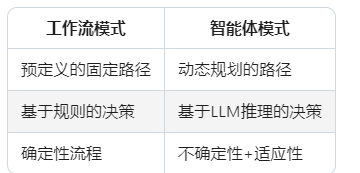目录:
🧠 智能体模式的核心差异

🔄 用ReAct模式实现的真正智能体
from typing import TypedDict, List
from langgraph.graph import StateGraph, END
import json
# 1. 定义状态 - 增加更多的思维痕迹
class AgentState(TypedDict):
user_query: str # 用户原始问题
thoughts: List[str] # 思维链:记录推理过程
next_action: str # 下一步要做什么
available_tools: List[str] # 可用工具列表
tool_input: dict # 工具输入参数
tool_output: str # 工具执行结果
final_answer: str # 最终答案
needs_human: bool # 是否需要人工介入
}
# 2. 定义 定义工具集 - 智能体的"技能"
def search_knowledge_base(query: str) -> str:
"""搜索知识库工具"""
print(f"🔍 正在知识库中搜索: {query}")
# 模拟搜索结果
knowledge = {
"billing": "计费问题通常涉及扣款金额、周期、退款等。请联系财务部门核实具体情况。"
"technical": "技术问题包括登录失败、页面错误、功能异常等。请尝试清除缓存或更换浏览器。",
"account": "账户问题包含注册、登录、注销、信息安全等。请确认操作步骤是否正确。"
}
return knowledge.get(query.split()[0], "未找到相关信息")
def check_order_status(order_ref: str) -> str:
"""检查订单状态工具"""
print(f"📦 正在查询订单: {order_ref}")
return f"订单 {order_ref} 状态: 已发货,预计明天送达"
def escalate_to_human(reason: str) -> str:
"""升级到人工工具"""
print(f"🚨 正在升级到人工,原因:原因: {reason}")
return "问题已分配给人工客服,请稍候..."
# 3. 核心核心智能体节点 - 具备思考和决策能力
def reasoning_agent(state: AgentState):
"""推理智能体:分析和决定下一步行动"""
from openai import OpenAI
client = OpenAI()
# 构建可用工具的描述
tools_description = """
可用工具:
1. search_knowledge_base(query): 搜索知识库获取解决方案
2. check_order_status(order_ref): 查询特定订单状态
3. escalate_to_human(reason): 升级到人工客服
"""
# 构建思维提示词
system_prompt = """
你是一个技术支持智能体。请按照以下步骤思考:
1. 分析用户问题的本质
2. 评估现有知识和工具是否能解决问题
3. 如果能,选择合适的工具并提供必要的输入参数
4. 如果不能,决定升级到人工客服
请用JSON格式回应:
{
"thought": "你的推理过程",
"next_action": "think|tool_name|respond|escalate",
"tool_name": "要使用的工具名(如果是tool)",
"tool_input": {"param": "value"}, # 工具输入参数
"response": "如果要直接回答的内容"
}
"""
# 获取之前的上下文
conversation_history = "\n".join([f"- {t}" for t in state.get("thoughts", [])])
response = client.chat.completions.create(
model="gpt-4",
messages=[
{"role": "system", "content": system_prompt},
{"role": "user", "content": f"用户问题: {state['user_query']}\n\n之前的思考:{conversconversation_history}\n\n{tools_description}"}
],
response_format={"type": "json_object"}
)
decision = json.loads(response.choices[0].message.content)
# 更新状态 - 记录 记录思维轨迹
current_thoughts = state.get("thoughts", [])
current_thoughts.append(decision["thought"])
state["thoughts"] = current_thoughts
state["next_action"] = decision["next_action"]
if decision["next_action"] == "tool":
state["tool_name"] = decision["tool_name"]
state["tool_input"] = decision["tool_input"]
return state
# 4. 工具执行节点
def tool_executor(state: AgentState):
"""工具执行器:根据智能体的决策调用具体工具"""
tool_name = state["tool_name"]
tool_input = state["tool_input"]
print(f"🛠️ 正在执行工具: {tool_name}, 输入: {tool_input}")
# 根据工具名分发执行
if tool_name == "search_knowledge_base":
result = search_knowledge_base(tool_input["query"])
elif tool_name == "check_order_status":
result = check_order_status(tool_input["order_ref"])
elif tool_name == "escalate_to_human":
result = escalate_to_human(tool_input["reason"])
state["tool_output"] = result
return state
# 5. 响应生成节点
def response_generator(state: AgentState):
"""响应生成器:综合所有信息生成最终回答"""
# 如果有工具输出,结合工具结果生成回答
if "tool_output" in state and state["tool_output"]:
state["final_answer"] = f"根据我们的分析: {state['tool_output']}"
else:
# 直接从推理结果中提取
state["final_answer"] = state.get("response", "抱歉,我暂时无法处理这个问题。")
return state
# 6. 构建智能体工作流
def create_agentic_support_system():
builder = StateGraph(AgentState)
# 添加节点
builder.add_node("reasoning_agent", reasoning_agent)
builder.add_node("tool_executor", tool_executor)
builder.add_node("response_generator", response_generator)
# 设置入口点
builder.set_entry_point("reasoning_agent")
# 添加条件边 - 这才是真正的"智能"所在!
def should_continue(state: AgentState):
"""决定下一步行动的智能路由"""
next_action = state["next_action"]
if next_action == "tool":
return "use_tool"
elif next_action == "respond":
return "generate_response"
elif next_action == "escalate":
state["needs_human"] = True
return "generate_response"
else:
return "continue_reasoning"
builder.add_conditional_edges(
"reasoning_agent",
should_continue,
{
"use_tool": "tool_executor",
"generate_response": "response_generator",
"continue_reasoning": "reasoning_agent"
}
)
# 从工具执行器返回到推理智能体
builder.add_edge("tool_executor", "reasoning_agent")
# 从响应生成器结束
builder.add_edge("response_generator", END)
return builder.compile()
# 7. 使用示例
if __name__ == "__main__":
# 创建智能体系统
agent_system = create_agentic_support_system()
# 测试用例
test_cases = [
"我的信用卡扣款金额不对",
"订单号ORD123456现在什么状态?",
"我忘记密码了怎么办",
"紧急!系统崩溃了,我要投诉!"
]
for i, query in enumerate(test_cases, 1):
print(f"\n{'='*60}")
print(f"🧪 测试用例 {i}: {query}")
print(f"{'='*60}")
# 初始化状态
initial_state = {
"user_query": query,
"thoughts": [],
"available_tools": ["search_knowledge_base", "check_order_status", "escalate_to_human"]
}
# 执行智能体系统
try:
result = agent_system.invoke(initial_state)
print("\n🤖 智能体执行轨迹:")
for j, thought in enumerate(result["thoughts"], 1):
print(f" {j}. {thought}")
print(f"\n💬 最终回答: {result['final_answer']}")
print(f"👤 需要人工: {result.get('needs_human', False)}")
except Exception as e:
print(f"❌ 执行出错: {e}")
🏗️ 智能体架构的核心思想
传统的if-else工作流:
用户输入 → if A then X → if B then Y → end
智能体工作流:
用户输入 → 思考该做什么 → 执行 → 观察结果 → 再思考 → ... → 满意后结束
🔍 第一步:状态设计 - 智能体的"记忆"
class AgentState(TypedDict):
user_query: str # 用户原始问题
thoughts: List[str] # 思维链:记录推理过程
next_action: str # 下一步要做什么
available_tools: List[str] # 可用工具列表
tool_input: dict # 工具输入参数
tool_output: str # 工具执行结果
final_answer: str # 最终答案
needs_human: bool # 是否需要人工介入
}
🤔 为什么这样设计状态?
-
thoughts: List[str]:
- 这是思维链的具体体现
- 记录智能体每一步的推理过程,便于调试和理解
- 举例:[“用户问扣款问题,这是计费类”, “我可以搜索知识库找解决方案”]
-
next_action: str:
- 这是智能体的"决策输出"
- 可选值:think|tool|respond|escalate
- 定义了智能体所有可能的行为类型
-
tool_input: dict:
- 通用的参数容器,可以适应任何工具
- 比如:{“query”: “信用卡扣款”}, {“order_ref”: “123”}
-
available_tools:
- 让智能体知道它有哪些"技能"可用
🛠️ 第二步:工具定义 - 智能体的"技能"
def search_knowledge_base(query: str) -> str:
"""搜索知识库工具"""
print(f"🔍 正在知识库中搜索: {query}")
# 模拟搜索逻辑
knowledge = {
"billing": "计费问题通常涉及扣款金额、周期、退款等..."
}
return knowledge.get(query.split()[0], "未找到相关信息")
🤔 为什么工具要这样设计?
- 函数即工具:每个工具都是一个Python函数
- 明确的接口:输入参数和返回值都很清晰
- 现实世界连接:这些工具可以替换成真实的API调用
🧠 第三步:核心推理智能体 - 智能体的"大脑"
这是最关键的部件,让我们仔细分析:
def reasoning_agent(state: AgentState):
# 1. 准备工具描述 - 告诉智能体它有什么能力
tools_description = """
可用工具:
1. search_knowledge_base(query): 搜索知识库获取解决方案
2. check_order_status(order_ref): 查询特定订单状态
3. escalate_to_human(reason): 升级到人工客服
"""
🎯 系统提示词设计
system_prompt = """
你是一个技术支持是一个技术支持智能体。请按照以下步骤思考:
1. 分析用户问题的本质
2. 评估现有知识和工具是否能解决问题是否能解决问题
3. 如果能,选择合适的工具并提供必要的输入参数
4. 如果不能,决定升级到人工客服
请用JSON格式回应:
{
"thought": "你的推理过程",
"next_action": "think|tool_name|respond|escalate",
"tool_name": "要使用的工具名(如果是tool)",
"tool_input": {"param": "value"}, # 工具输入参数
"response": "如果要直接回答的内容"
}
"""
🤔 为什么提示词要这样设计?
- 结构化思考:强制智能体按步骤分析
- JSON格式化:确保输出的机器可读性
- 明确的字段:每个字段都有特定用途
🔄 第四步:构建工作流图 - 智能体的"行为模式"
这是LangGraph的精髓所在:
4.1 决策函数 - 智能体的"直觉"
def should_continue(state: AgentState):
"""决定下一步行动的智能路由"""
next_action = state["next_action"]
if next_action == "tool":
return "use_tool" # 需要执行工具
elif next_action == "respond":
return "generate_response" # 可以直接回答
elif next_action == "escalate":
state["needs_human"] = True
return "generate_response"
else:
return "continue_reasoning" # 还需要继续思考
🎯 这个函数的运作逻辑:
接收当前状态 → 查看next_action字段 → 根据值决定下一步去哪 → 返回目标节点名称
4.2 图形构建过程
# 创建图形框架
builder = StateGraph(AgentState)
# 添加节点 - 相当于组建团队
builder.add_node("reasoning_agent", reasoning_agent) # 军师
builder.add_node("tool_executor", tool_executor) # 工匠
builder.add_node("response_generator", response_generator) # 发言人
# 设置谁第一个发言
builder.set_entry_point("reasoning_agent")
# 建立沟通渠道
builder.add_conditional_edges(
"reasoning_agent", # 从谁那里发出消息
should_continue, # 用什么逻辑决定传给谁
{ # 可能的接收者名单
"use_tool": "tool_executor",
"generate_response": "response_generator",
"continue_reasoning": "reasoning_agent"
}
)
# 建立固定链接 - 工匠做完活一定要向军师汇报
builder.add_edge("tool_executor", "reasoning_agent")
# 发言人说完就结束
builder.add_edge("response_generator", END)
🚀 第五步:执行流程详解
让我们追踪一个具体例子的完整执行过程:
输入:
initial_state = {
"user_query": "我的信用卡扣款金额不对",
"thoughts": [], # 刚开始,没有任何思考记录
"available_tools": ["search_knowledge_base", "check_order_status", "escalate_to_human"]
}
第1轮执行:
1.推理智能体工作:
- 输入:只有用户问题,thoughts为空
- 过程:分析问题 → 发现是计费问题 → 决定搜索知识库
输出JSON:
{
"thought": "用户在询问信用卡扣款问题,这明显是个计费类问题,我应该先用search_knowledge_base工具查找相关解决方案"
"next_action": "tool",
"tool_name": "search_knowledge_base",
"tool_input": {"query": "信用卡扣款金额不对"}
}
此时状态变为:
{
"user_query": "我的信用卡扣款金额不对",
"thoughts": ["用户在询问信用卡扣款问题,这明显是个计费类问题..."],
"next_action": "tool",
"tool_name": "search_knowledge_base",
"tool_input": {"query": "信用卡扣款金额不对"},
"final_answer": "",
"needs_human": False
}
决策函数判断:
- next_action = “tool”
- 返回:“use_tool”
第2轮执行:
2.工具执行器工作:
输入:知道要调用search_knowledge_base,参数是{“query”: “信用卡扣款金额不对”}
执行结果:
state["tool_output"] = "计费问题通常涉及扣款金额、周期、退款等。请联系财务部门核实具体情况。"
#状态变化:
{
... # 保持其他字段不变
"tool_output": "计费问题通常涉及扣款金额、周期、退款等。请联系财务部门核实具体情况。"
}
由于建立了固定边:add_edge(“tool_executor”, “reasoning_agent”)
→ 自动返回到推理智能体
第3轮执行:
3.推理智能体再次工作:
- 输入:现在有了工具执行的结果
- 新的思考:“搜索结果显示这是标准的计费流程问题,需要联系财务部门。我可以直接给用户这个建议。”
输出JSON:
{
"thought": "知识库给出了明确的指引,我可以直接回答用户了",
"next_action": "respond",
"response": "根据我们的知识库,您的信用卡扣款问题需要联系财务部门核实具体情况。他们会帮助您解决。"
}
决策函数再次判断:
- next_action = “respond”
- 返回:“generate_response”
第4轮执行:
4.响应生成器工作:
- 综合所有信息生成友好回答
- 状态:`“final_answer”: “根据我们的分析,您的信用卡扣款问题需要联系财务部门核实具体情况…”
---
## 🎯 智能体决策的四种路径
### 路径1:思考 → 工具 → 思考 → 响应 ✅























 被折叠的 条评论
为什么被折叠?
被折叠的 条评论
为什么被折叠?










